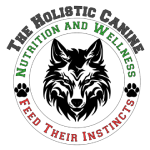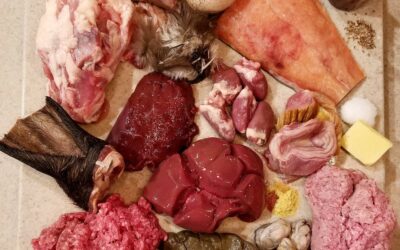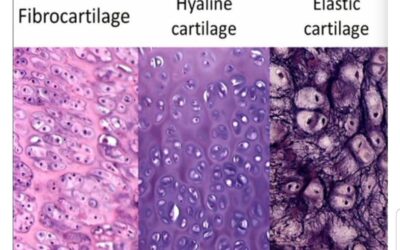What you need to know
Sourcing is often the most difficult aspect of raw feeding. Quality and affordability are generally the two most important factors and considerations when searching for nourishing ingredients that will be used to fulfill your dog’s energy and nutritional requirements. I place quality at the top of my list while affordability is often a necessity rather than a choice.
Purchasing meats, fish, organs, bones, and various other ingredients from the human food market is my recommendation, hands down. Even better, partnering with a local farmer or raising your own livestock for food products is ideal. In this way, you know exactly what and how much of each ingredient is going into your dog’s body. You have full control and can offer a variety of high quality nourishing ingredients that will produce optimal health and wellbeing in your dog.
Premade “complete and balanced” commercial raw products are extremely convenient and are becoming increasingly more popular. However, with that popularity many new raw food companies and sourcing businesses are popping up in nearly every state in this nation as well as abroad. Sadly, I am finding that as more people enter into the raw food business market, money often becomes the game and quality can suffer. Unless a premade is AAFCO “complete and balanced,” is clearly labeled with the exact percentages of every ingredient in the mix, lists the guaranteed analysis, and the company or business can verify the source of each ingredient in the product, you will be left wondering whether or not you are providing a quality food that fulfills all of your dog’s nutritional needs. Quality and nutritional value need to be the first and highest priority of every commercial and raw food supplier.
Which leads me to my biggest concern: 80/10/10 grinds. Unless clearly stated, these products are not complete and balanced diet options. I am seeing these options becoming far more popular than commercial premade completes due to their affordability and ease of creating. Unfortunately, too many pet parents are feeding these grinds exclusively (as complete diets) not realizing that their dogs may very well be missing vital nutrients that can lead to serious deficiency conditions or chronic disease down the road.
80/10/10 grinds come labeled or unlabeled and follow a basic 80/10/10 rule of 80% meat, 10% organs, and 10% bone. They most often contain muscle meat, heart, liver, kidney, and bone. I highly recommend questioning whether the supplier or manufacturer has consulted with a canine nutritionist or if they have the proper knowledge to create an 80/10/10 that is as nutritionally sound as is possible, as well as safe. Keep in mind also that if a supplier is obtaining cheap or even free meat to create a grind it will produce a poor quality, nutritionally unsound, and potentially dangerous product.
The most pressing concern you should be aware of if you are purchasing premades or a grind mix is the sourcing. 3D and 4D product use is becoming very popular in raw grinds. This creates raw food products that are affordable and competitive, but also potentially fatal.
3D animal products are taken from animals that are still alive before processing. The three “Ds” stand for:
- Diseased
- Dying
- Downed (as from lameness, illness, weakness, etc.)
4D animal products are all of the above with the addition of the animal being dead before the opportunity to slaughter and process hygienically. The forth “D” is:
- Dead (or Destroyed).
According to the publication An Overview of the Rendering Industry [1], “Approximately 49 percent of the live weight of cattle, 44 percent of the live weight of pigs, 37 percent of the live weight of broilers, and 57 percent of the live weight of most fish species are materials not consumed by humans.” To avoid waste, these “inedible” products are sent to plants for animal feed and rendering. “The most important and valuable use for these animal by-products is as feed ingredients for livestock, poultry, aquaculture, and companion animals.”
While most of the inedible products discussed in the publication above come from animals that are fit for human consumption (known as human-grade), there is the other side of the industry. Often during processing in USDA regulated plants, some of the animals are found to be diseased, dying, unable to walk off transport vehicles (down), or may even die (3D/4D). These animals/products are identified as unfit for the human food market and must be marked to avoid entering into the human food chain. How is this done?
During processing, if an animal product has been identified as unfit for the human market, staining the meat or products with charcoal, fish meal, or adding bone or a chemical agent(s) to produce an easily identifiable color, odor, or taste is necessary to avoid these unfit products from entering into the human food market. This is called denaturing. Denatured products are what are known as feed-grade.
The pet food industry obtains denatured feed-grade products at extremely low costs to be used in the manufacture of commercial kibble, canned, dehydrated, and raw pet food products. While using these animal products for pet foods may seem like a viable solution to avoid wasting valuable feed animals, denatured products can and do cause harm to pets when they are consumed. While charcoal, fish meal, and bone denaturing may be safe for pets to consume, chemical denaturing can be potentially lethal. You also have to consider the additional impact of your pet consuming diseased or dead animals which may pose a whole host of risks on its own. Keep in mind that 3D/4D animal products can also be obtained by smaller pet food manufacturers and local raw food suppliers for use in raw food grinds such as 80/10/10. The USDA warns that the handling of 4D meat that is served raw to pets can be a serious health hazard to both the pet parents and their pets.
Take a look at the list of denaturing agents approved by the USDA:
- 4% coarsely ground hard bone
- 6% coarsely ground hard bone
- 6 % tannic acid solution exposure for 1 minute followed by water bath immersion, followed by a 1 minute immersion of 0.022 percent FD&C yellow No. 5 coloring solution
- 1 part FD&C green No. 3 coloring + 40 parts water + 40 parts liquid detergent + 40 parts oil of citronella
- 0.0625 percent tannic acid exposure followed by immersion in a water bath, followed by 0.0625 percent ferric acid dipping solution
- phenolic disinfectant conforming to commercial standards CS 70-41 or CS 71-41
- Cresylic disinfectant
- Crude carbolic acid
- FD&C blue No. 1 coloring
- FD&C blue No. 2 coloring
- FD&C green No. 3 coloring
- Finely powdered charcoal or black dyes
- Kerosene, fuel oil, or used crankcase oil
- No. 2 fuel oil, brucine dissolved in a mixture of alcohol and pine oil or oil of rosemary, finely powdered charcoal
- Any ‘other proprietary substance’ approved by the USDA
What are some other concerns you should be made aware of when sourcing your raw ingredients? Always be leery of and question:
- Products sold for $1 per pound and lower (especially grinds)
- Meats marked “trim”
- Grinds containing 1% or 2% bone
- Grinds without guaranteed analysis
- Unlabeled grinds
- Products with unknown or undisclosed origin
- Meat from animals fed GMO feed
- Meat from animals injected with hormones/antibiotics
- Unknown tissue found in bulk meat products
- Meat with a strong or offensive odor
- Meat with an odd color
- Products that cause your dog to suddenly become picky
- Products that cause your dog to vomit
- Overly fatty or greasy grinds
- Meats that are brown when thawed
- Meat or organs containing spots or unknown attached tissue
- Grinds sold for racing dogs
- Freezer burned product (may indicate the product being very old)
- Expired products or frozen products with a package date that exceeds 1 year
- Products with air in sealed bags
- Poultry feet with black spots on the bottom of foot pad and toes
- All fish grinds (especially salmon)
- A company or business unwilling to disclose information about products
The only way to be absolutely sure of what you are feeding your pet is to either feed a DIY nutrition plan from only human-grade USDA inspected ingredients sold in stores and Farmer’s Markets or to find a reputable raw food company/supplier that is 100% transparent about their ingredients, recipes/formulas, and sourcing. When it comes to your pet’s nutrition needs and health, you are at the helm. Choose your path wisely!
©2019 Kimberly Lloyd, PhD, BCHHP, Cert Raw Dog Food Nutritionist
[1] http://assets.nationalrenderers.org/essential_rendering_overview.pdf



